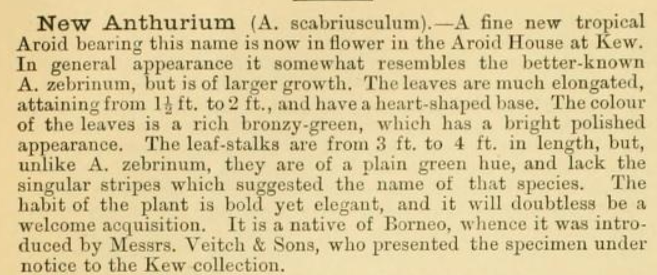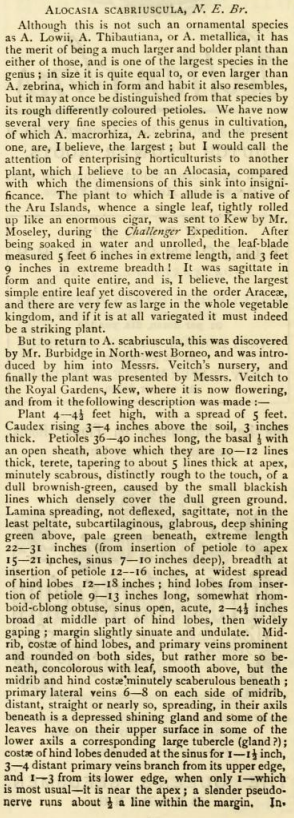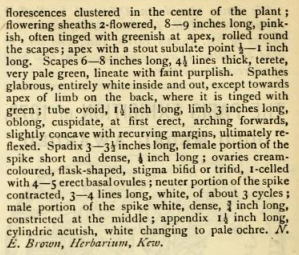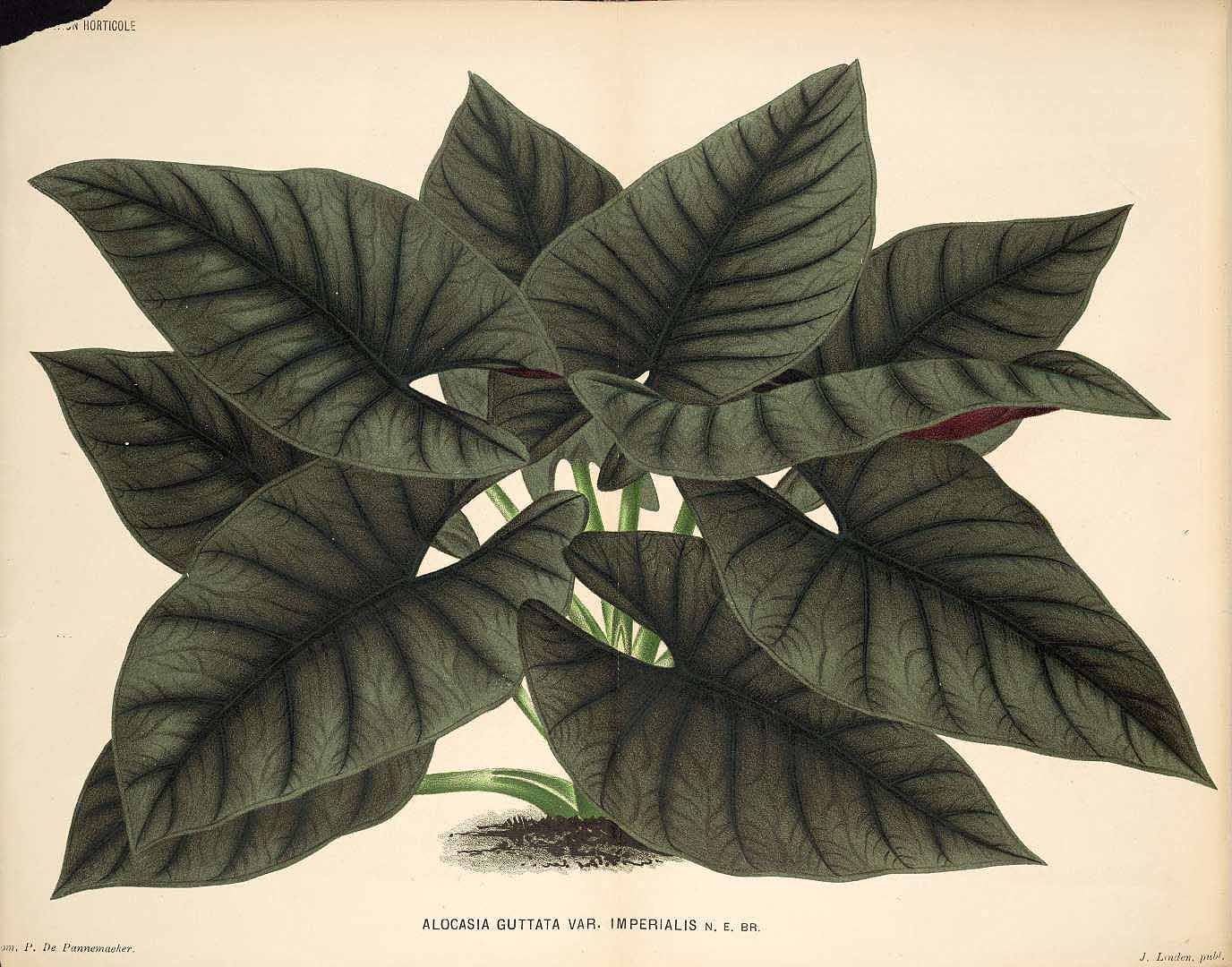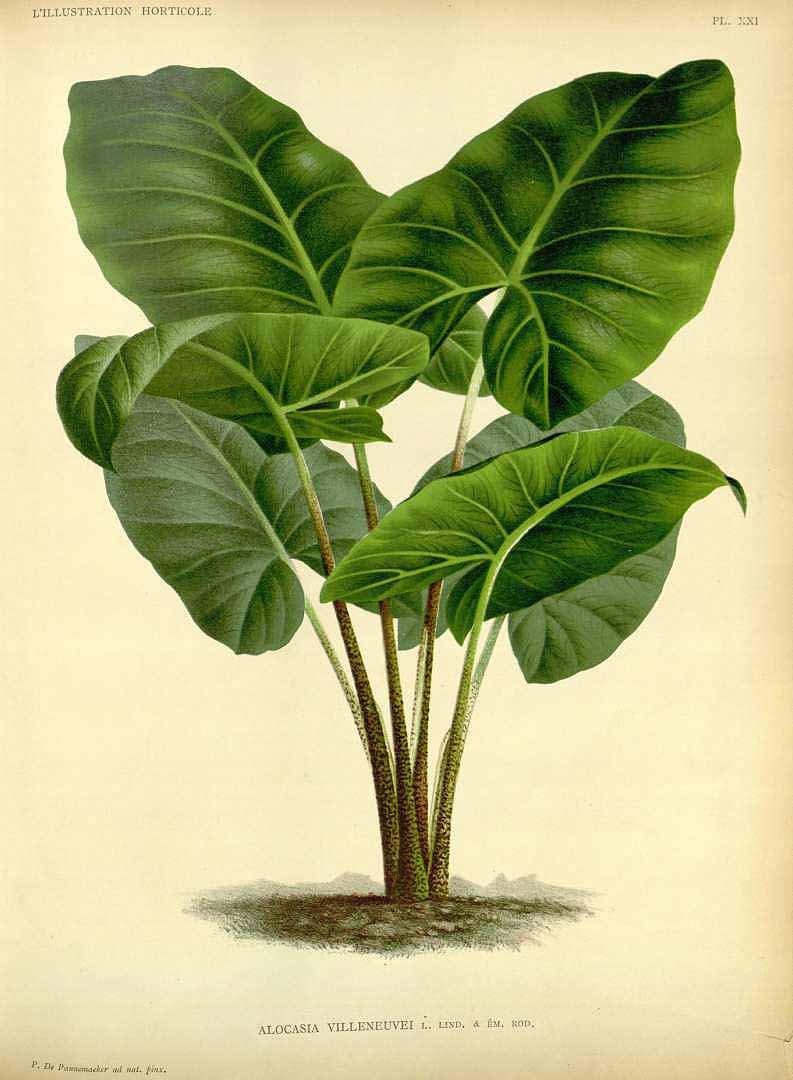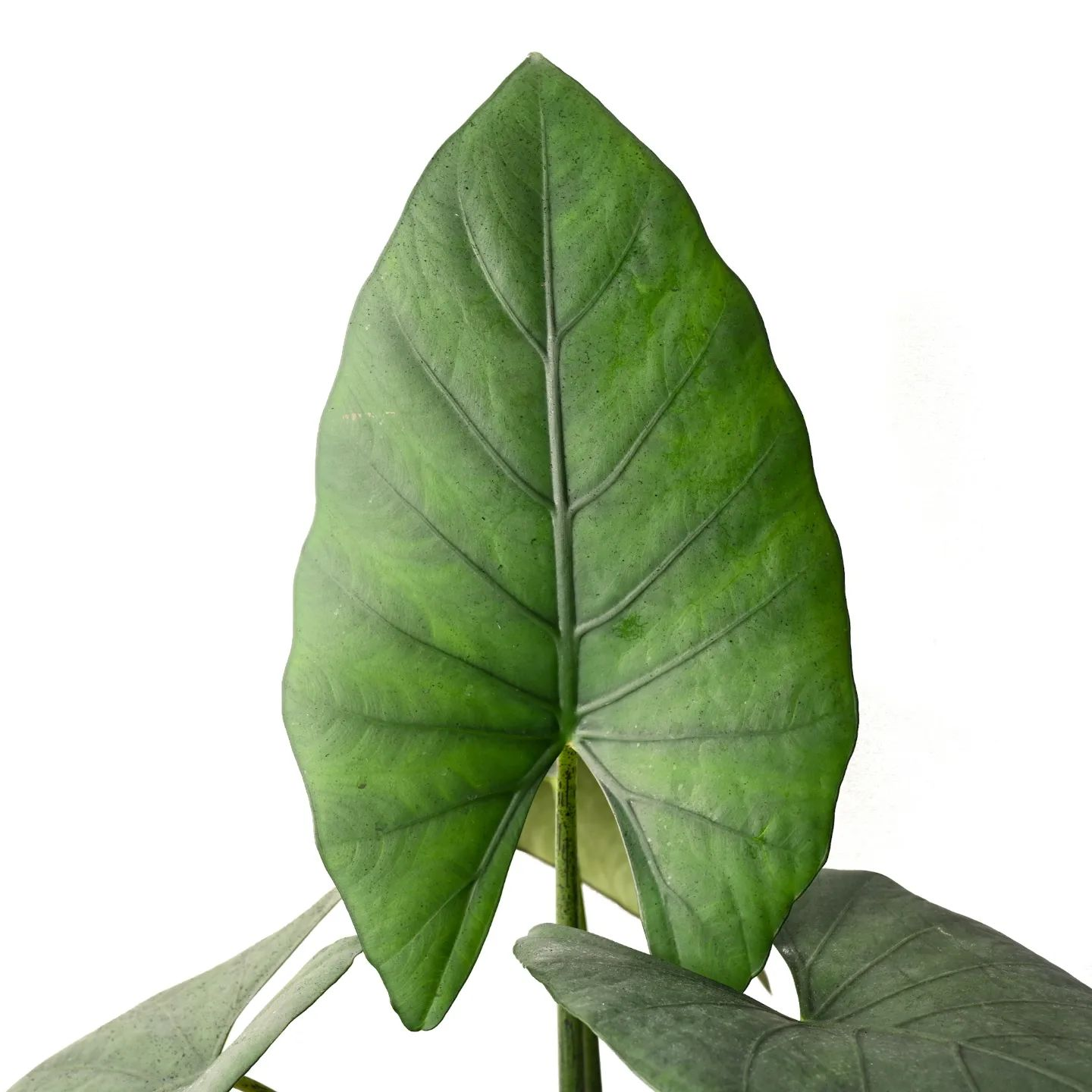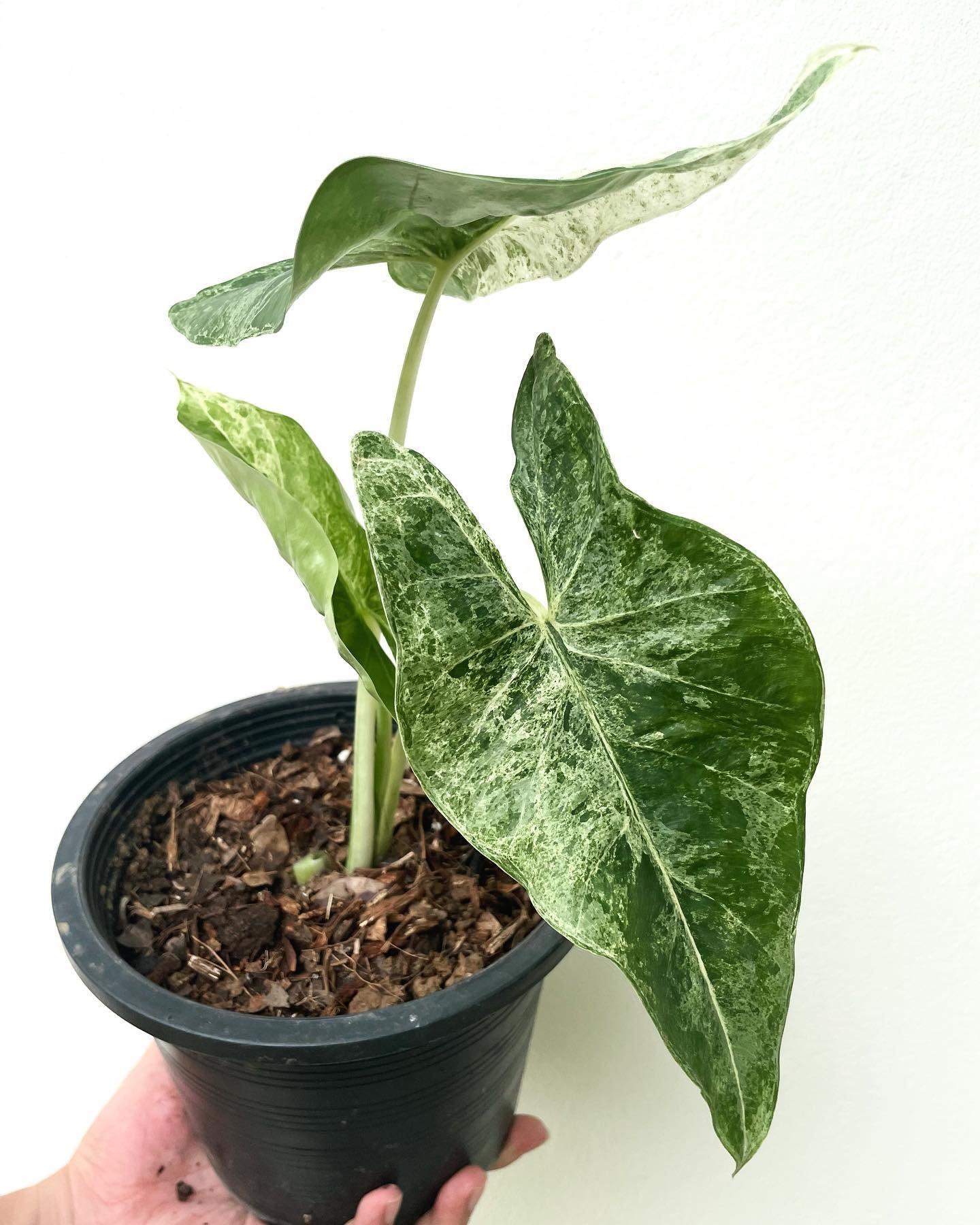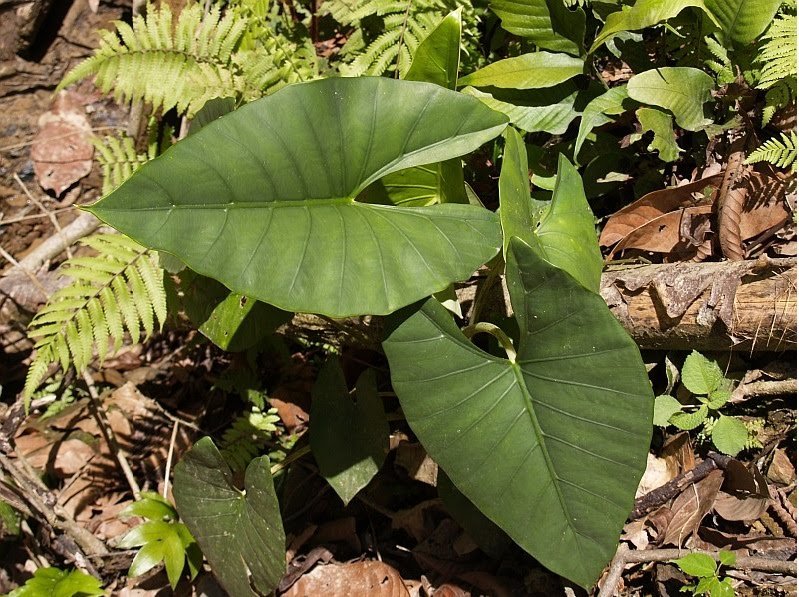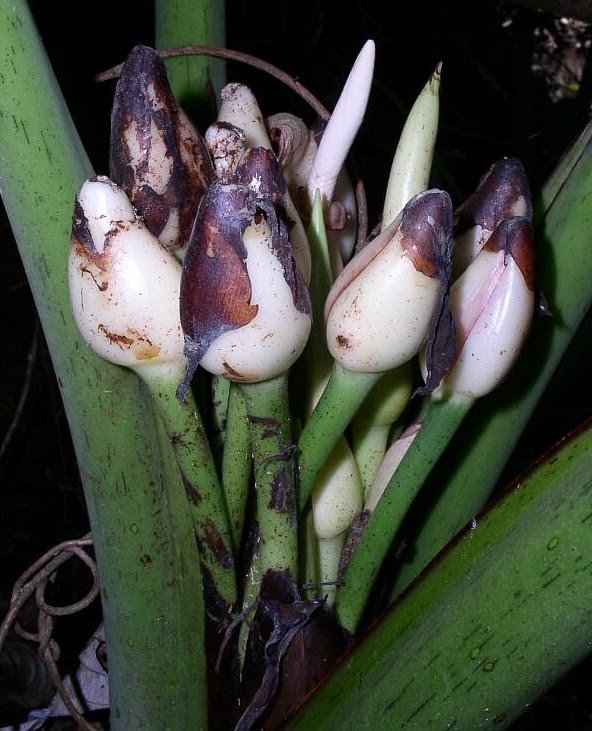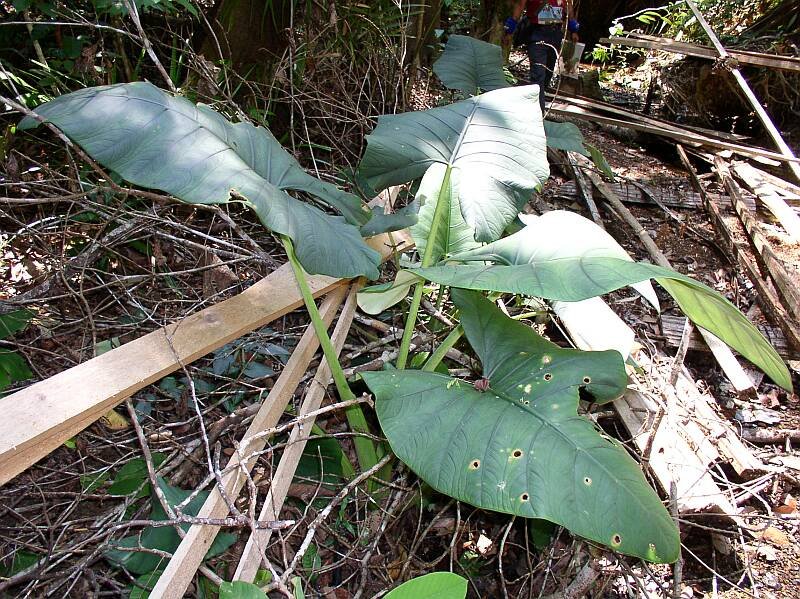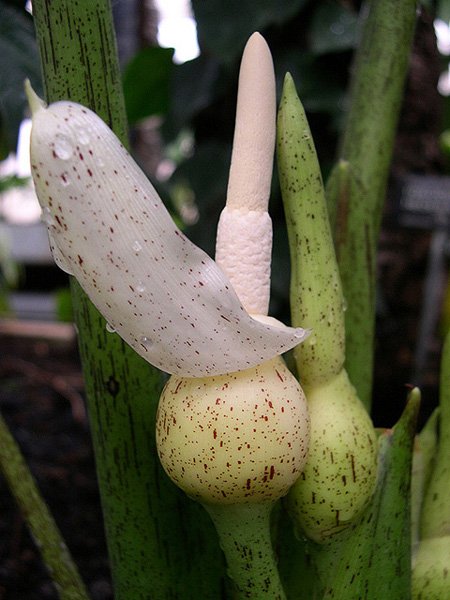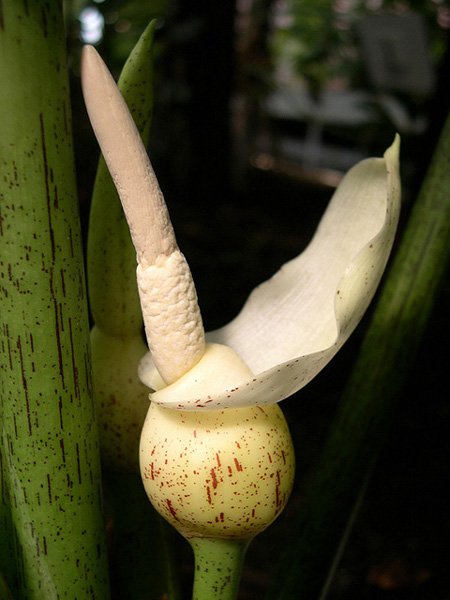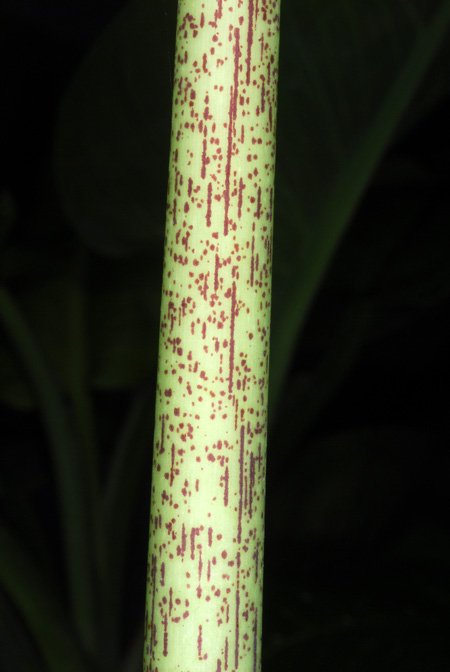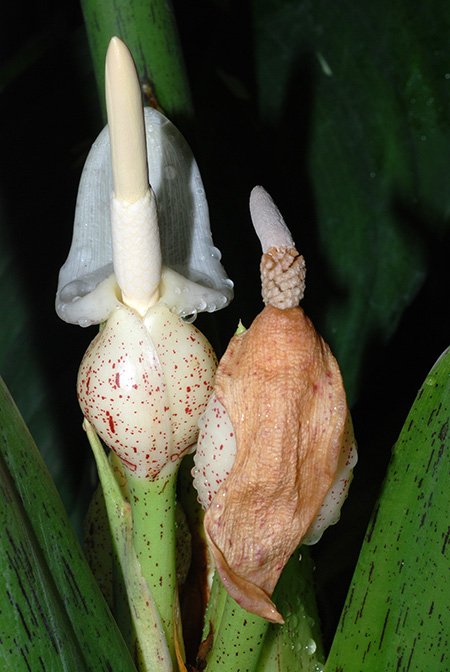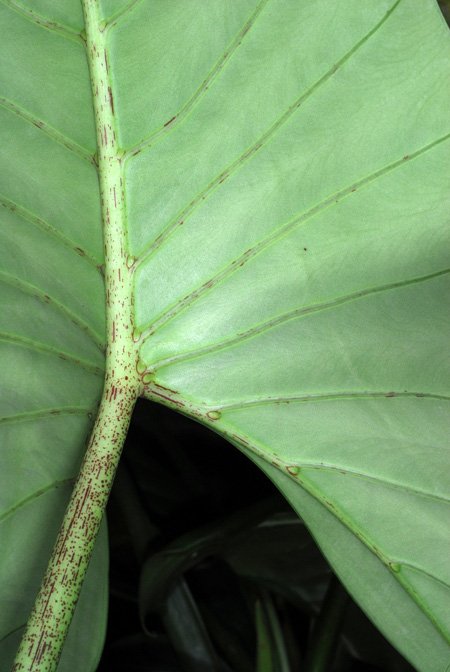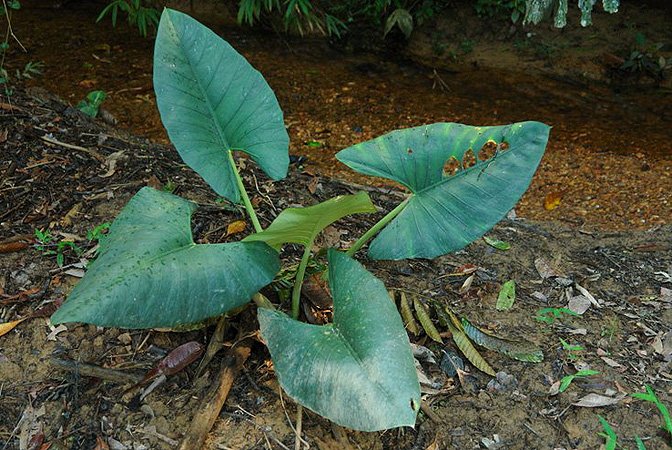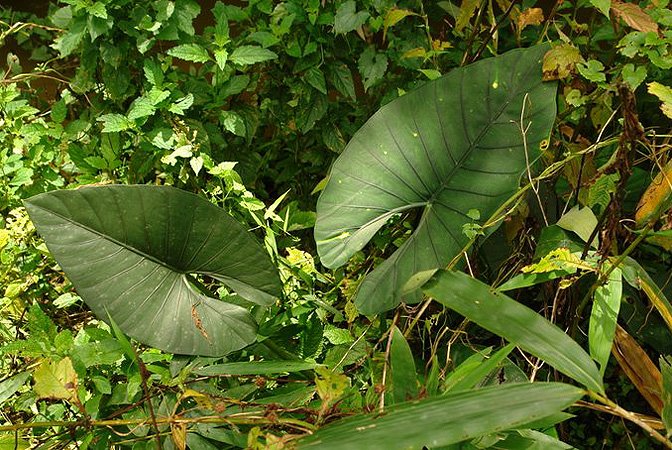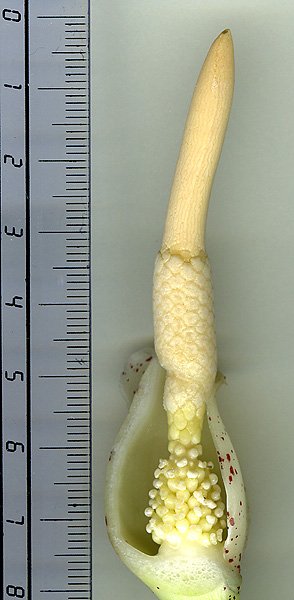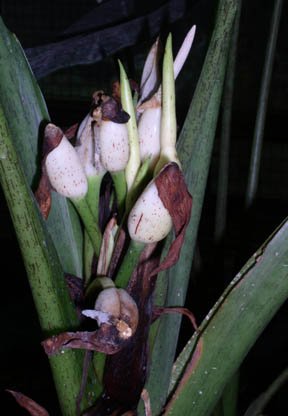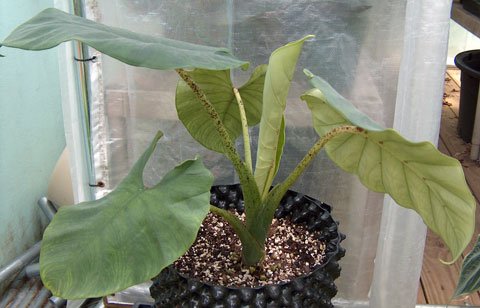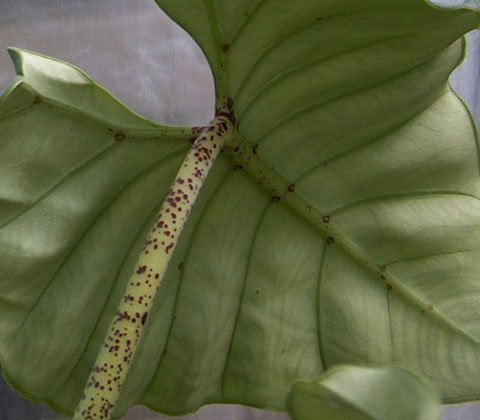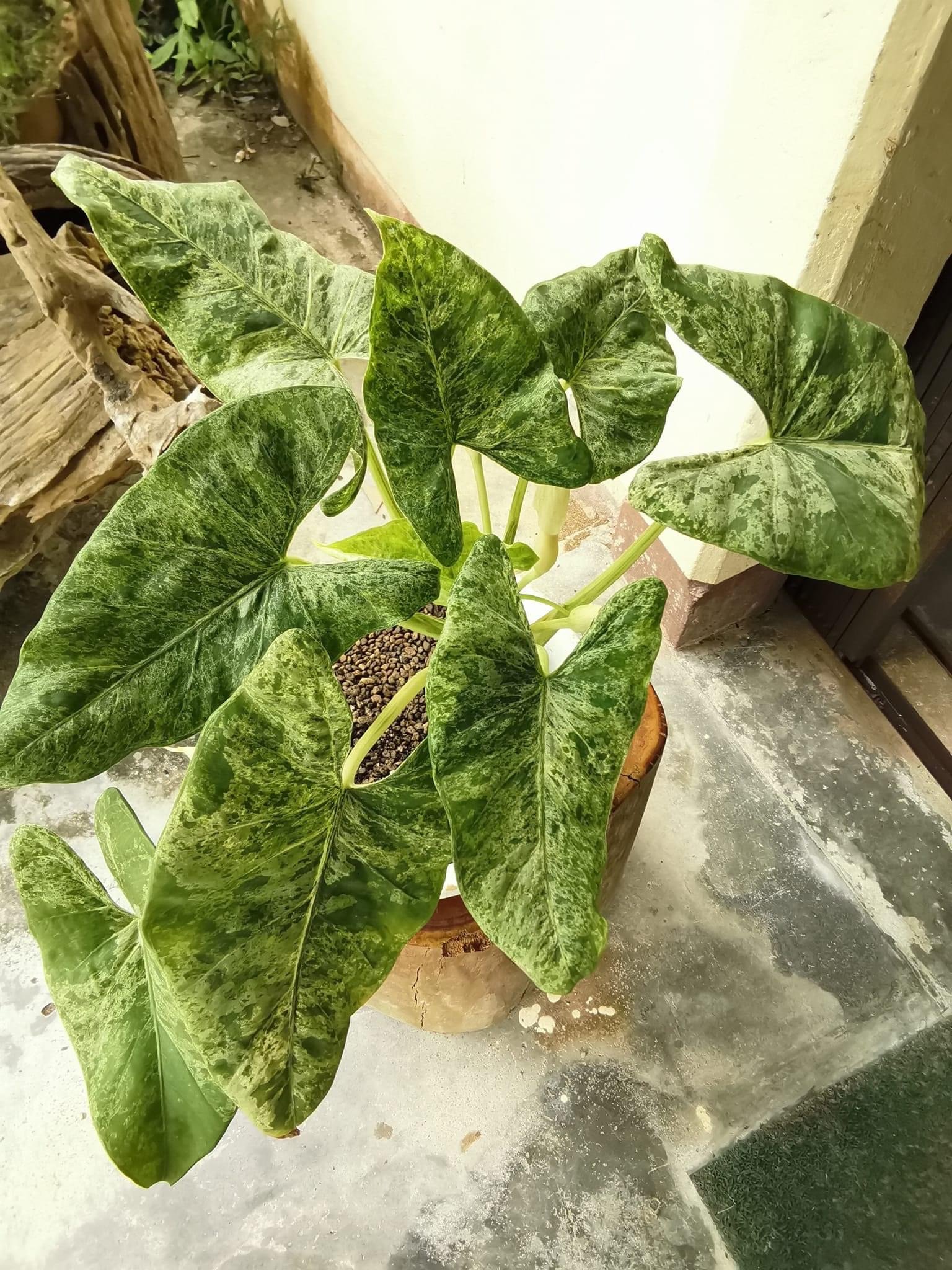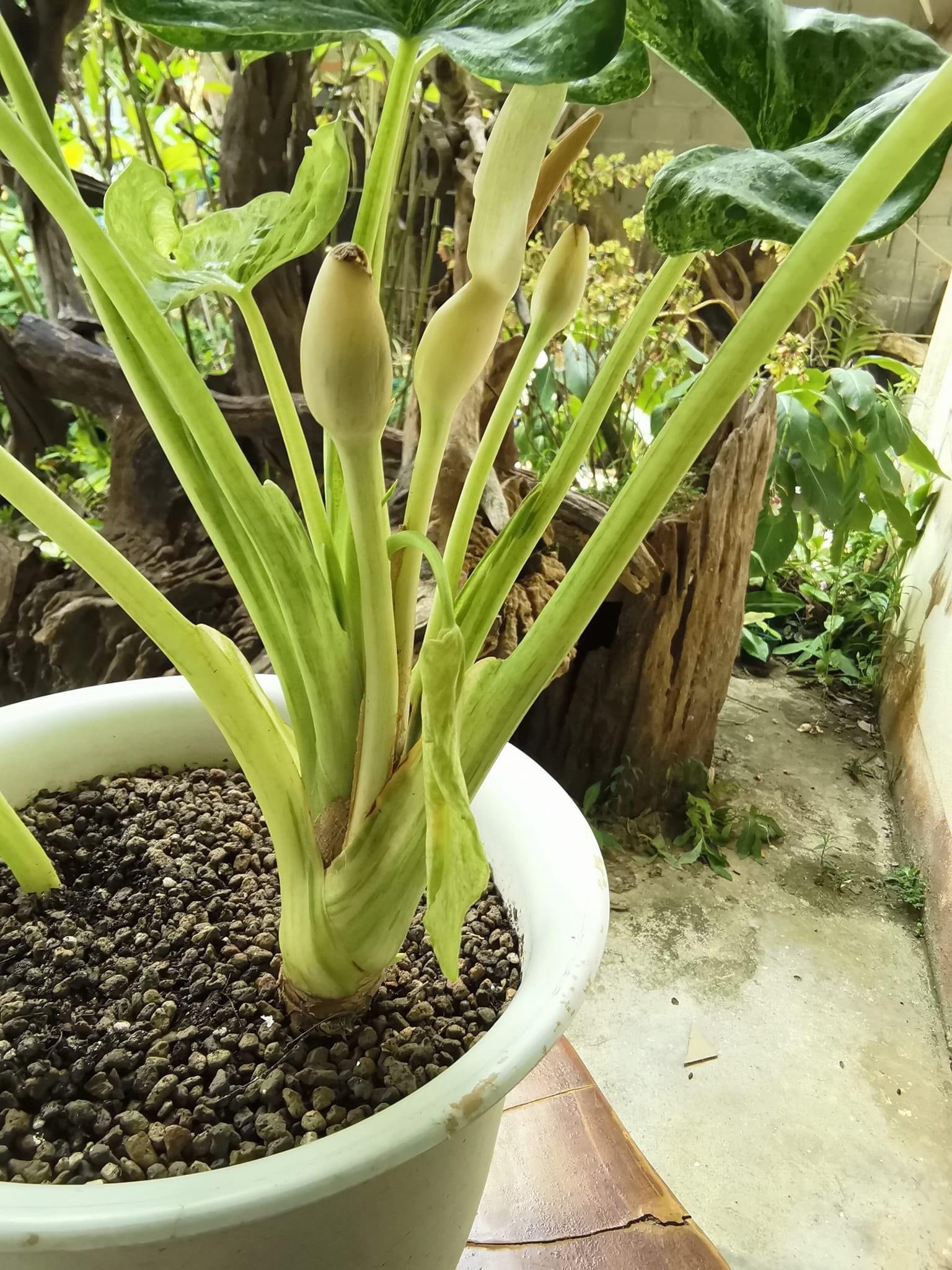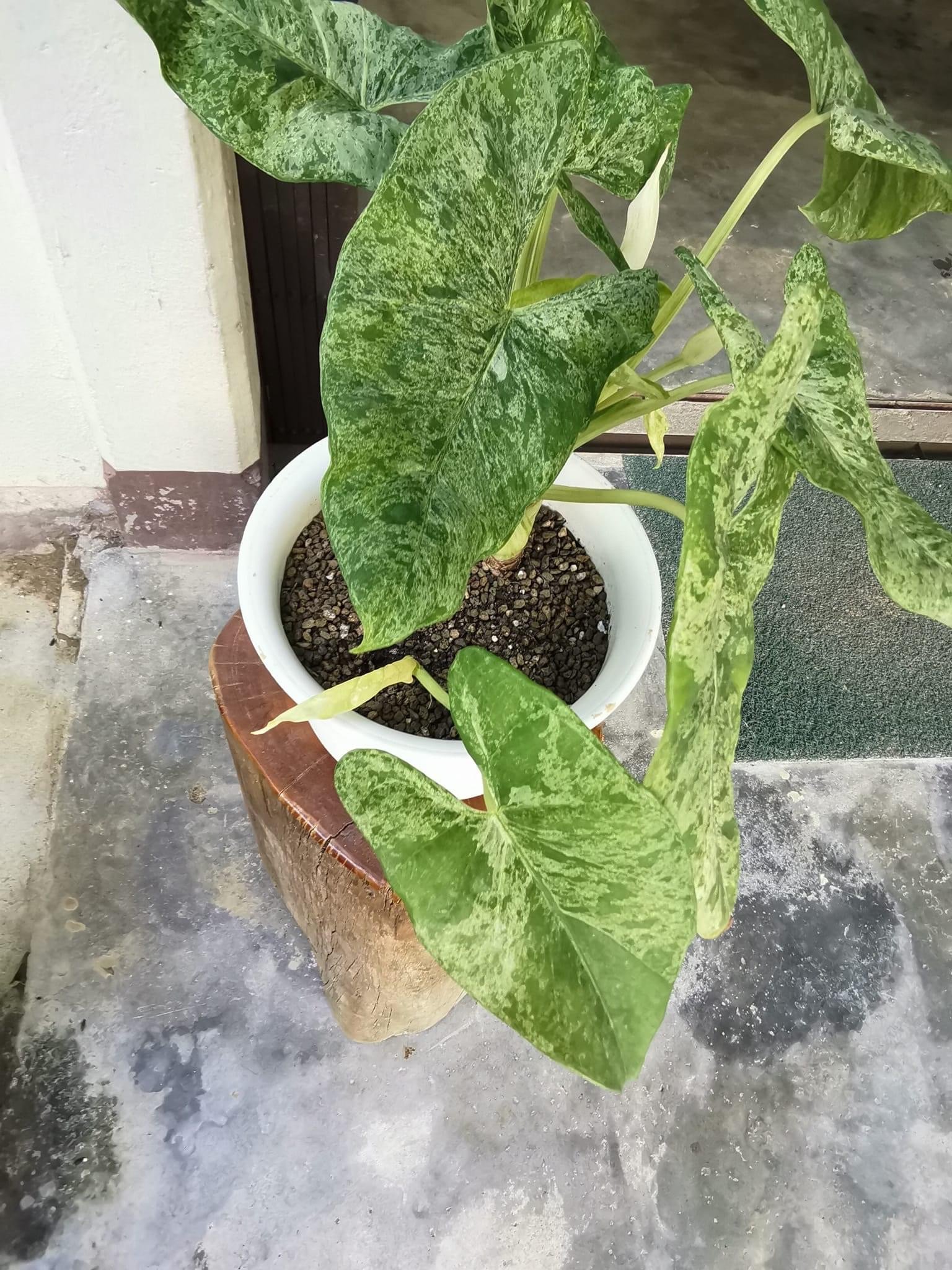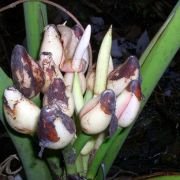ALOCASIA SCABRIUSCULA
ORIGINAL DESCRIPTION:
This publication originally incorrectly classified this species as an Anthurium, but published a correction to Alocasia in the same issue
Photo by LasPlantasIndo
SYNONYMS:
HOMOTYPIC SYNONYMS: N/A
HETEROTYPIC SYNONYMS: Alocasia guttata, Alocasia guttata var. Imperialis, Alocasia imperialis, Alocasia villeneuvei
ACCEPTED INFRASPECIFICS: N/A
DISTRIBUTION: Borneo
CLIMATE: Tropical humid climate
Humidity is moderate throughout the year, ranging from 60% to 70%
Temperature is varies between the seasons - within the range of 48°F/9°C to 88°F/31°C during the day. Minimum temperatures never dip below 45°F/7°C
Rainy and humid season (October to May) and a dry season between June and October. The average annual rainfall is 1,200 mm
ECOLOGY: Lowland forest to hill forest to ca. 1200 alt., often in disturbed areas, in swampy to well-drained sites, river banks, occasional on roadsides and in plantations.
SPECIES DESCRIPTION:
Robust herb ca. 0.5-1.2 m tall; rhizome ca. 5-10 cm thick; leaves several together; petioles typically spreading and proportionately rather short about equalling the length of the blade, ca. 40-100 cm long, smooth to scabrid or sparsely to densely minutely pubescent, rarely plain pale greygreen, usually ornamented with irregular sparse to dense purple-brown dots, circles and longitudinally aligned broken fine lines, sheathing in the lower ca. 1/3; blade ovato-sagittate to broadly ovato-sagittate, ca. 40-85 cm long, adaxially dark to light grey-green and sometimes conspicuously darker along the main venation, abaxially pale grey-green to rich purple, occasionally flushed purple on both surfaces, very thickly leathery to almost succulent; anterior lobe widest at ca. V4 of the way distal to the petiole insertion, the apex acute to obtuse; anterior costa with (4-)5-8 primary lateral veins on each side diverging at 45-60° and with conspicuous green, purple or purple-ringed axillary glands, these sometimes also present in the axils of the larger secondary veins; secondary venation ± flush with the lamina to somewhat impressed on both surfaces (depending on thickness of blade), often abaxially obscure or conversely sometimes conspicuous through pigmentation of the bordering lamina, forming more or less welldefined interprimary collective veins; posterior lobes ca. 1/3-1/2 the length of the anterior, usually acute, sometimes rounded, the inner sides usually narrowly to very narrowly oblanceolate, sometimes wider becoming ovate; posterior costae diverging at 60-120°, naked in the sinus for ca. 2-4 cm, rarely with lamina to the sinus, but never peltate as adult plants
INFLORESCENCE:
Inflorescences several together in a tight low cluster; peduncle hardly or not exserted from the subtending cataphylls and leaf sheaths; cataphylls ovate, rather fleshy, often marked like the petiole; spathe greenish to yellowish white to ivory, often speckled purple, sometimes suffused purple throughout or the limb purple, (7-)9-10 cm long, constricted (2-)2.5-3(-5) cm from the base; lower spathe thick, narrowly to broadly ovoid; limb oblong to ovate, 2-3 cm wide, eventually completely reflexed, the tip apiculate to acuminate for 1.5 cm; spadix very shortly stipitate for ca. 1.5 mm, (5.5-)6-7 cm long; female zone (l-)ca. 1.5 cm long, subcylindric to slightly conic, squat, (0.8-)1.2-1.5 cm wide at base; ovary pale green to cream, ovoid, 1-2 mm long; style slender, 0.5-1 mm, facing diagonally outand up-wards; stigma cream (turning yellow in spirit) mostly 2-lobed; sterile interstice (4-)7-8 mm long, somewhat narrower than female zone at base and ca. 3-4 mm diam., narrowly obconic, basally ca. 2 whorls of somewhat lax white subcylindric synandrodia ca. 1.5 mm diam., distally composed of ca. 3 whorls of synandrodia ca. 2-3 mm diam., closely resembling synandria; male zone ivory, ca. 1.5-2 cm long, 5-7 mm diam., often somewhat constricted level wth spathe constriction, (1/4-)1/3-l/2 (-2/3) within the lower spathe chamber; synandria 2-3 mm diam., rhombohexagonal to somewhat irregular; thecae not overtopped by synconnective; appendix ivory, (2-)2.5-3 cm long, tapering to slightly spindle shaped, 5-7 mm diam. at base, the tip usually shghtly obtuse; fruiting spathe ca. 4.5 cm long broadly ovoid, white, usually speckled purple.
VARIEGATED FORMS: WHITE MOTTLED
ETYMOLOGY: The specific epitet scabriuscula comes from the Latin scăbrōsus, meaning scabrous, rough
NOTES:
“The Garden V.16 P.232 (1879)” reported that this species was discovered in NW Borneo by Mr. Burbidge, on an expedition for the Veitch brothers
1. As conceived here, this is a highly variable species. Typical forms have ovatsagittate and thick, dark to mid grey-green leaves with the inner sides of the posterior costae very narrowly oblanceolate. These forms conform with the type of Alocasia guttata N.E. Br. Rather less common are large forms with well developed, broad posterior lobes, which conform with the type of Alocasia scabriuscula. There are intermediates. There is also very considerable variation in the thickness of the leaf blade, from distinctly though rather thinly leathery, to blades almost 5 mm thick and virtually succulent. The petiole varies considerable in texture from finely pubescent to scabrid to smooth.
2. Alocasia scabriuscula s. 1. is only narrowly distinguished morphologically from A. ridleyi, which has relatively longer posterior lobes, longer peduncles, a more slender inflorescence and is a limestone element confined to SW Sarawak.
3. Of the specimens cited below, Beaman et al 7451 is tentatively ascribed to this species. It differs in the rather long posterior lobes, long peduncles and paired infructescences. Hay 9381 has unusually thinly textured leaves and atypically small inflorescences, with the spathe only ca. 7 cm long, but conforms in other respects. Poulsen 235 is evidently taken from an exceptionally robust plant, as the lower spathe is ca. 5 cm long.
4. There are a number of colour variations, including specimens with red-purple leaf undersides or the leaves entirely suffused with purple (e.g. Afriastini 406).
5. No original material has been found that could serve as a type of Alocasia villeneuvei. The protologue, though singing the praises of this plant in horticulture, contains almost no botanical information. However, it is attributed to Borneo. Dimensions are not given, but the plant is clearly robust. The description does mention brown spotting on the petioles, which is clearly apparent in the illustration. This feature is found in some forms of the Alocasia princeps complex, and to varying intensity in Alocasia sarawakensis, Alocasia reginae and Alocasia scabriuscula. The illustration is not of high quality, but Alocasia sarawkensis can be eliminated as there is no sign at all in the plate of that species' conspicuous interprimary collective veins. Moreover, it is hardly ornamental. The leaves are too broad and the petioles relatively too short for any larger forms of Alocasia princeps. Alocasia reginae is small and characteristicaly has the inner side of the posterior costae narrowly lanceolate, while the plant depicted has broadly developed lamina there, which matches the type of Alocasia scabriuscula. Furthermore, the upper side of older leaves is depicted dark dull grey-green which is also typical of this species. Alocasia villeneuvei is therefore epitypified accordingly. The epitype, Johns 6721, has broad posterior lobes, matching well those apparent in the original illustration of Alocasia villeneuvei.
6. Alocasia imperialis and Alocasia reginae may have been first described by Linden, just prior to N.E. Brown, in an 1883 or 1884 catalogue of the Compagnie Continentale d'Horticulture Gand. However, I have not been able to locate the relevant issues. The plants were exhibited by the Compagnie in May 1884 at the International Exhibition of the Imperial Society of Horticulture at St Petersburg, on which Brown reported in the Gardener's Chronicle in the same year, describing (validly but unintentionally) Alocasia imperialis. There he also mentioned and briefly described Alocasia reginae, but said it was the same species as Alocasia imperialis, thus invalidating it.
Other specimens seen: SARAWAK: Santubong, Carrick & Enoch JC/191 (SING); Cult. RBG Sydney Acc. No. 940505 ex Niah Caves area along track from Niah town. Hay et al. Alocasia in West Malesia and Sulawesi 257 9354 (NSW); Cult. RBG Sydney Acc. No. 940471 ex 2.5 km past Kemena R. bridge on Bintulu-Sibu Rd., Hay et al. 9317 (NSW); Cult. RBG Sydney Acc. No. 940531 ex Kg Sentah, nr Kuching, Hay et al. 9381 (NSW); Kuching, Hewitt 6 (SING); Semunsan Wildlife Sanctuary, Kiew RK885 (KEP); Anap, Ulu Muput Kanan, path to Bukit Kemantan, Paie S19507 (US); Matang, Ridley s.n. (SING); Santubong, Ridley s.n. (SING). BRUNEI: Temburong Distr., Bukit Biang, Forman 897 (K) & 931 (K); Temburong, Batu Apoi F.R., Sg Baki, Poulsen 108 (K); Temburong, Batu Apoi F.R., Sg Temburong, Poulsen 235 (K) SABAH: Ranau Distr., Pinosuk Plateau, W Mesilau R. at waterworks dam, Beaman et al. 7451 (K, US); Cult. RBG Sydney Acc. No. 960516 ex 2.5 km above main Maliau Falls, G. Rara F.R., Hay et al 12045 (NSW); Cult. RBG Sydney Acc. No. 960520 ex Kinabatangan, Kalabakan VJR, Hay et al. 12006 (NSW). KALIMANTAN: Central Kalimantan, sei Sampit, Kualakuayan, Afriastini 406 (BO); Pulau Lemoehoetan, Hallier 328 (L).

